4.5 Soviet Scuba Pistol
The Soviet SPP-1 underwater pistol: Essential beachware
07/5/13 6:00 AM | by Chris Eger
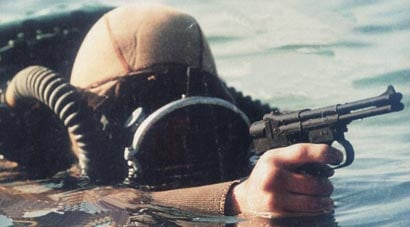

Early British Navy frogman.
So you are a frogman and, while you are froggin it up, you come snorkel-to-snorkel with another wetsuit-clad combat swimmer. You reach for your dive knife but come up short because you realize that you just brought a knife to a gunfight. Well, that dastardly commie has a SPP-1 pistol, and it works underwater.
Why the need
Underwater divers have been used by militaries around the world for centuries. As far back as the 1843, the British Royal Navy and others used divers for salvage. However, these early divers were tethered to the surface by lines that fed oxygen. The first ‘frogmen’ who swam independent of support ships had to do so with just a set of fins, a facemask, and a knife. These early combat swimmers reconned beaches in World War 2 as well as planted explosives when the opportunity arose.
It wasn’t until self-contained breathing apparatus including open and closed circuit varieties came about in the late 1940s that military divers could stay below the surface for longer periods. This new technology led to a greater flexibility of operations that included the laying of limpet mines on enemy ships in harbor. Soon most modern navies had specialized teams of frogmen optimized for underwater recon, sabotage, and other dirty deeds done dirt-cheap.

The Soviet crusier, Ordzhonikidze.
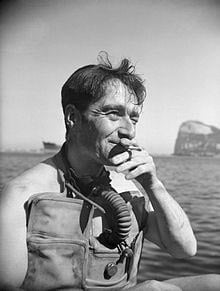
Lionel Kenneth “Buster” Crabb.
In 1956, the Soviets and British both caught a dose of diver versus diver combat. The cruiser Ordzhonikidze was visiting the British base of Portsmouth and Lionel Kenneth “Buster” Crabb, a former Royal Navy diver thought to be in the employ of British Intelligence, disappeared in the harbor during the ships visit. Fourteen months later, his body, sans head and hands, washed up. In 2007, a former Russian frogman finally claimed to the press that he had killed Crabb with a knife as the Brit poked around the Ordzhonikidze some fifty years before. It was the only weapon available.
It was this incident and others that may never be known that led the Soviets to develop an underwater pistol.
Design

SPP1 underwater pistol open for loading.
The man selected to turn out such a weapon was Vladimir Simonov (no relation to SKS inventor Sergei Simonov) of the TsNIITochMash plant. His design was a simple four-barreled hinged-break pistol that shot a very special round. More or less a giant derringer, the gun had one round in each chamber with an opening in the bolt face of each for the striker. The double-action trigger cycled the rotating striker, firing each 8-inch long smoothbore barrel in turn with each trigger pull. Since it was designed to be carried and used in the harshest saltwater of the world’s oceans, the gun was to be built of non-corrosive metals with specially coated internals and plastic furniture. To accommodate the thick neoprene gloves of divers operating in subzero waters, the trigger guard and combination safety lever/barrel hinge lock are oversized.
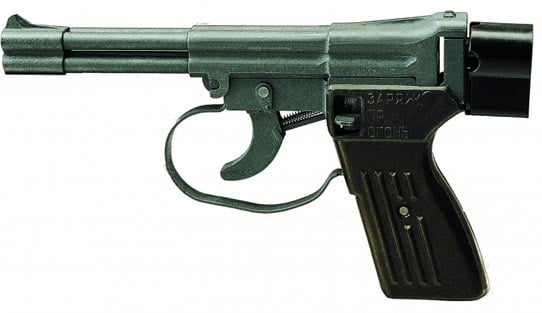
SPP-1 underwater pistol.

SSP-1 underwater pistol.
The resulting gun was quite long, at 9.65-inches overall (more than an inch longer than the Colt 1911, which you can see shoot underwater here) with an empty weight of 30-ounces. One reason for its magnum-size envelope is to allow greater tolerances for the gun to be fired while completely immersed at depths up to 150-feet.
Classified as the Spetsialnyj Podvodnyj Pistolet (Russian for ‘Special Underwater Pistol,’ apparently to differentiate it from the plain underwater pistol) model 1, its moniker is commonly shortened to SPP-1 when written.

SPP-1 with ammunition and other accessories.
The ammunition intended for this frog-gun was the specially designed SPS round, consisting of a 4.5mm caliber mild-steel flechette dart loaded atop a 39.5mm bottlenecked case. The overall look is as if you took a .223 case and stuck a four-inch steel dart into the opening, only stranger. When fired underwater it is drag-stabilized and accurate to about 50-feet. A blunt tip and finned tail allowed it to create a wave of cavitation in front of it as it moved through the water, retaining velocity over distance. This hopped up spear/bullet is capable of penetrating hard glass facemasks and thick neoprene wetsuits.

4.5×39.5 R. Note the blunt tip to help the projectile cavitate.
While both the gun and the ammunition can still be fired on land, range out of water is poor as is accuracy. For quick loading/reloading, a spring steel clip that can be replaced as a unit holds all four rounds together. This is helpful in dark, underwater environments by divers with gloved hands.
Use and competition
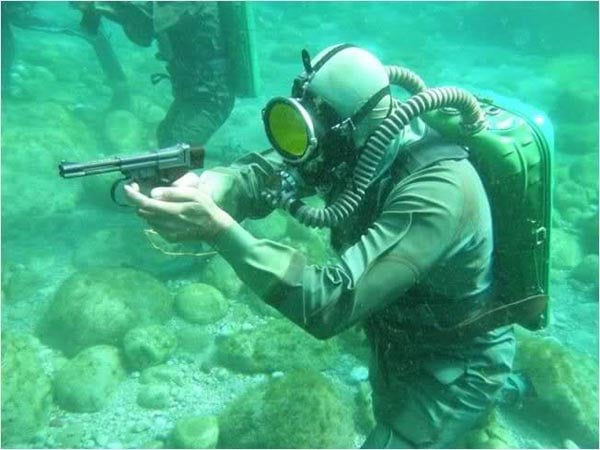
Soviet SPP-1 underwater pistol in use by Russian frogman.
Designed throughout the 1960s the SPP-1 was placed into low-rate production at the Tula works in 1971. The Soviets during this period had thousands of naval spetsanz troops, roughly their version of our Navy Seals, that were undoubtedly issued these guns. While their operations during the Cold War are written in invisible ink in books that you aren’t cleared to read, you can no doubt safely wager they were used occasionally. The success of the design led to Simonov’s creation of a larger, APS underwater assault rifle system.

Chinese knock-off SPP-1 pistol.
When word hit the street about the Russki’s underwater arsenal, the NATO guys went about getting their own cooler version. Made in the 1970s, the German-made HK P11 met the Soviet 4-shot 4.5×39.5R with a 5-shot 7.62x36mm underwater dart gun. Incapable of being reloaded, the device was in effect disposable. The German gun was bulkier but slightly smaller and fired from an electrical ignition—but that’s another article.
While it’s believed the HK scuba sniper has long been discontinued, the SPP-1 is still going strong and is still in current production by TsNIITochMash (where it was invented.) The Chinese liked the design so much that they created the “Type QSS05 underwater pistol,” a near copy, from the Soviet original. Today, as the slightly improved SPP-1M, it’s used by the Russian Navy as well as sold for export to any country close to Moscow with a bank account.
Планы ядерного удара США по территории СССР (Дропшот)
Планы ядерного удара США по территории СССР (Дропшот)
Согласно секретному документу, датированному 15 сентября 1945 года, Пентагон намеревался нанести сокрушительный удар по Советскому Союзу за счет скоординированного ядерного удара по крупным городским агломерациям.
Все крупные города Советского Союза были включены в перечень 66 «стратегических» целей. Были составлены таблицы, в которых были отражены площадь каждого города в квадратных милях, а также соответствующее количество ядерных бомб, необходимых для уничтожения его инфраструктуры и жителей.
Для уничтожения каждого из крупнейших городов СССР, в том числе, Москвы, Ленинграда, Ташкента, Киева, Харькова и Одессы потребовалось бы 6 атомных бомб.
По оценкам Пентагона, для того, чтобы «стереть с карты Советский Союз», потребовалось бы в общей сложности 204 бомбы. В качестве целей для ядерного удара были выбраны 66 крупных городов.
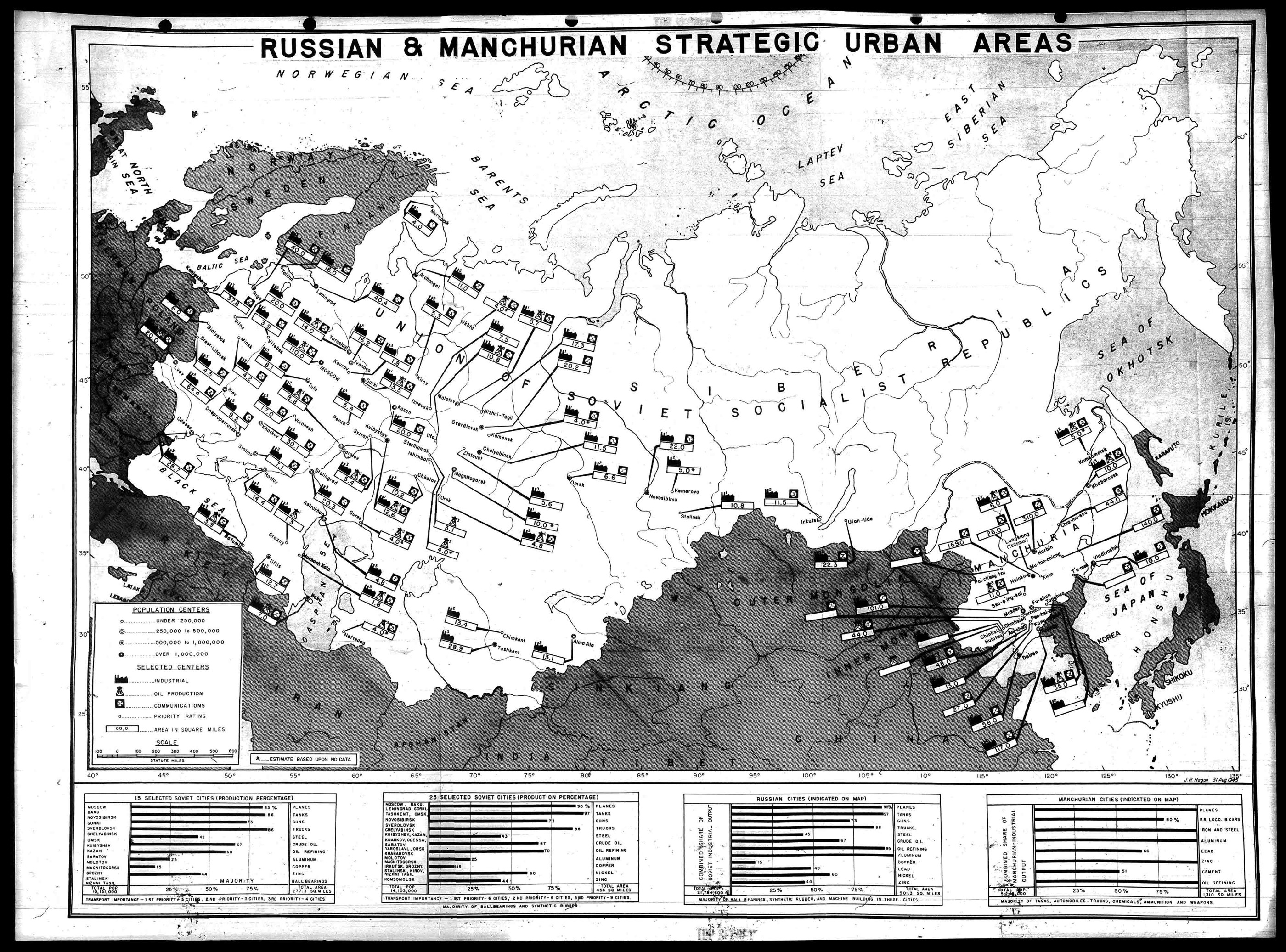
Оптимальное количество бомб, необходимых для проведения данной операции, составляло 466 штук.
В течение первых семи секунд после взрыва одной-единственной бомбы, сброшенной на Хиросиму, погибло 100 тысяч человек. Можно представить, что бы произошло, будь все 204 атомных бомбы сброшены на крупные города Советского Союза, как это было указано в секретном плане американцев, разработанном во время Второй Мировой войны.
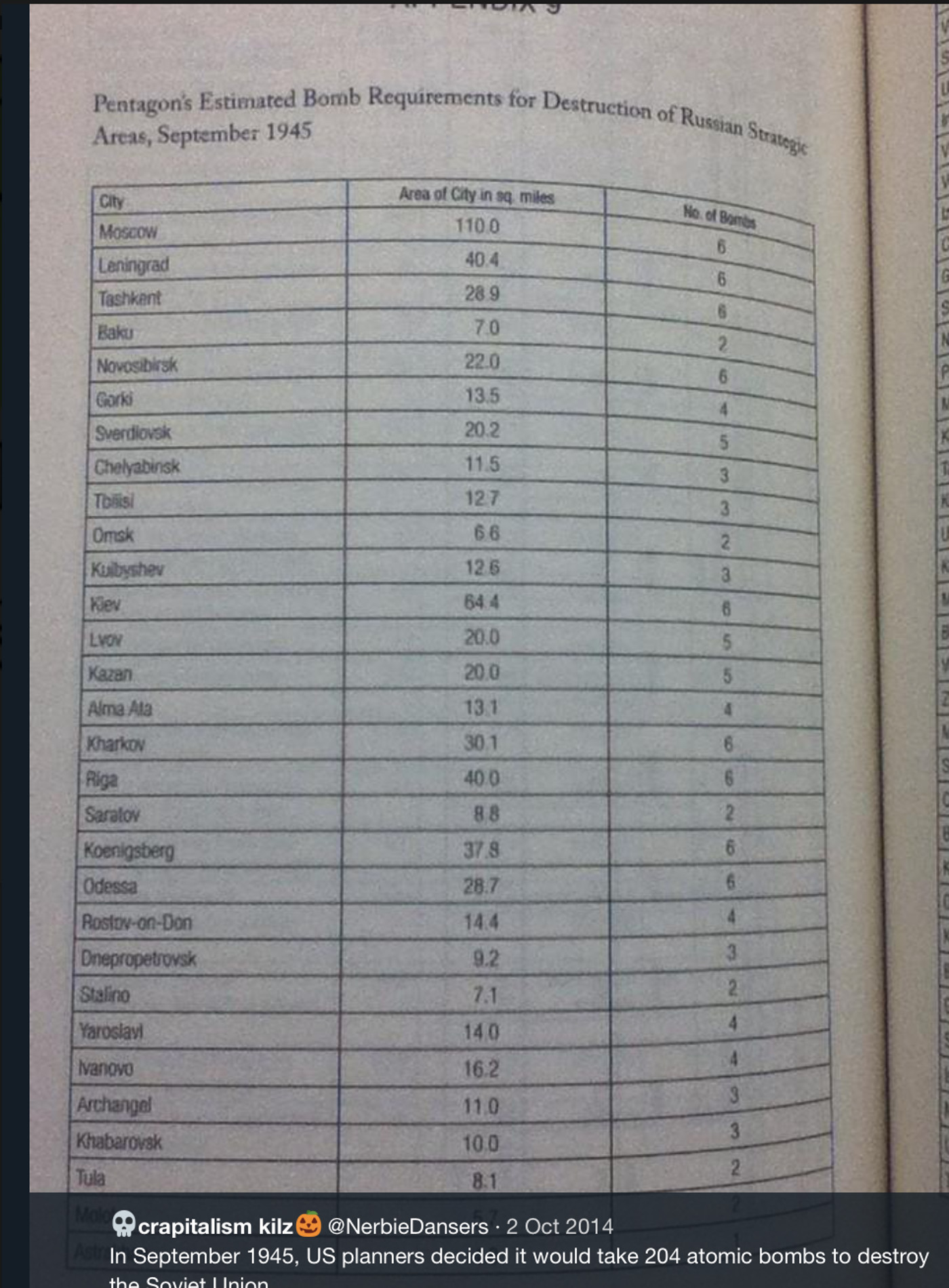
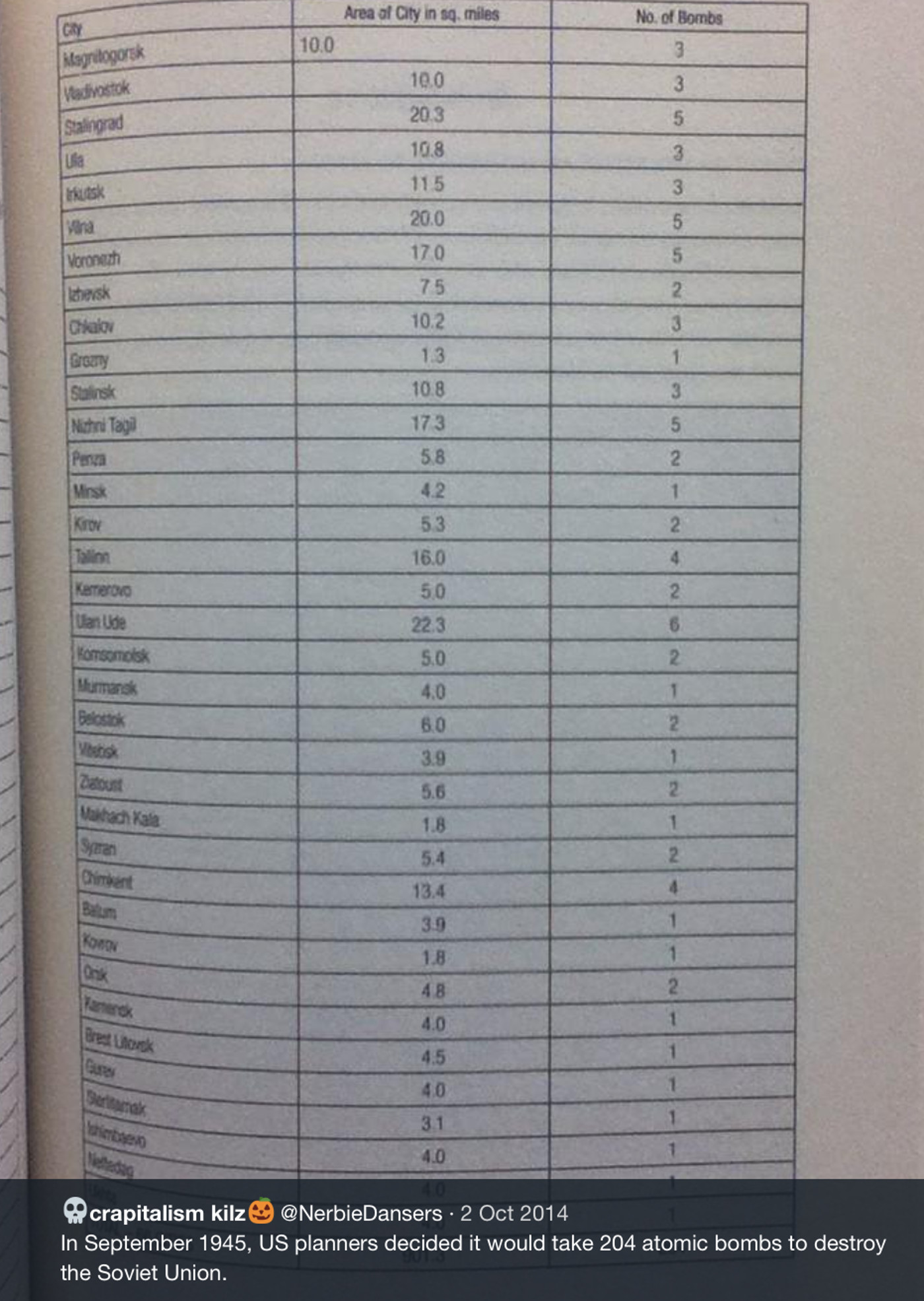
Документ, в котором содержалась столь нечеловеческая боевая задача, был издан в сентябре 1945 года, практически спустя 1 месяц после бомбардировок городов Хиросима и Нагасаки (6 и 9 августа 1945 года) и за 2 года до начала в 1947 году Холодной Войны.
Однако, датированный 15 сентября 1945 года секретный план был сформирован в более ранний период, а именно – в самый разгар Второй Мировой войны, когда США и СССР находились в тесном союзе.
Стоит отметить то, что о печально известном «Манхэттенском проекте» Сталин был впервые официально проинформирован Гарри Трумэном в ходе Потсдамской Конференции, состоявшейся 24 июля 1945 года – практически за 2 недели до бомбардировки Хиросимы.
Манхэттенский проект был начат в 1939 году, за 2 года до вступления США во Вторую Мировую войну в декабре 1941 года. К началу 1942 года Кремль уже был полностью осведомлен о секретном Манхэттенском проекте.
Были ли бомбардировки Хиросимы и Нагасаки в августе 1945 года проведены Пентагоном для оценки результативности более крупной атаки на Советский Союз, где было бы задействовано свыше 204 атомных бомб?
Ключевые документы, в которых был отражен план нанесения бомбового удара по 66 городам Советского Союза, были в конечном счете доработаны спустя 5-6 недель после бомбардировок Хиросимы и Нагасаки.
В своем труде под названием «Потребности в первых запасах ядерного оружия в сентябре 1945 года» Алекс Веллерштейн писал: «15 сентября 1945 года – спустя менее двух недель после формальной капитуляции Японии и окончания Второй Мировой – Норстад направил копию отчета об оценке генералу Лесли Гровсу, который по-прежнему возглавлял Манхэттенский проект и который, в ближайшее время, в любом случае должен был отвечать за производство любых типов бомб, которые могут запросить ВВС США. Как вы можете догадаться, данный документ был выпущен под грифом «СОВЕРШЕННО СЕКРЕТНО, РАСПРОСТРАНЕНИЕ ОГРАНИЧЕНО», который сохранялся на протяжении Второй Мировой войны»
Кремль был в курсе существования созданного в 1945 году плана бомбардировки 66 советских городов.
Существует документальное подтверждение того, что США занимались разработкой плана геноцида населения Советского Союза.
Для понимания причин Холодной Войны, которая официально началась в 1947 году, необходимо знать, что разработанный в сентябре 1945 года план Вашингтона по проведению бомбардировок и тотального уничтожения 66 советских городов сыграл ключевую роль в начале гонки ядерных вооружений.
В ответ на полученные в 1942 году доклады разведки о Манхэттенском проекте, который представлял угрозу СССР, в 1949 году Советский Союз разработал свою собственную атомную бомбу.
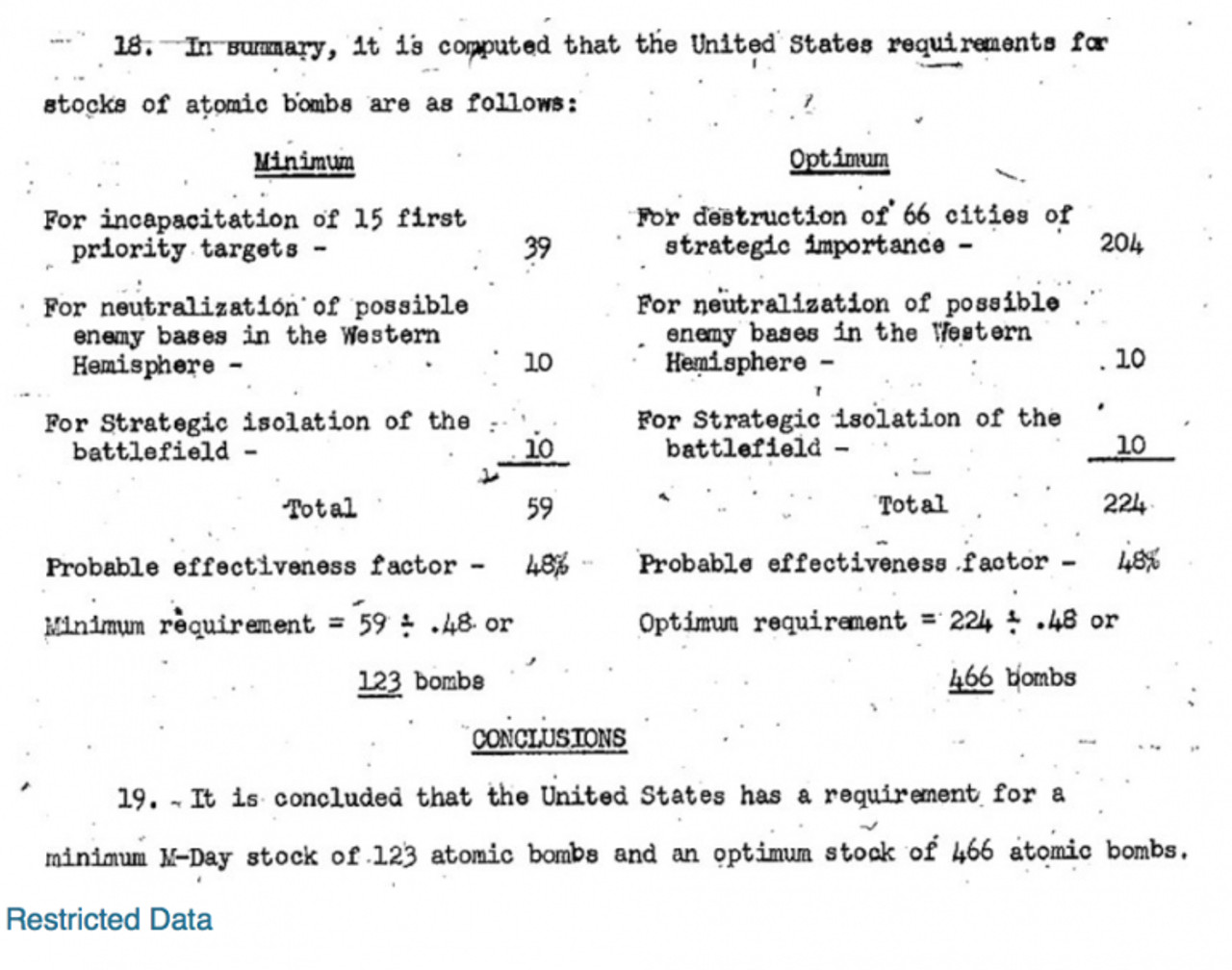
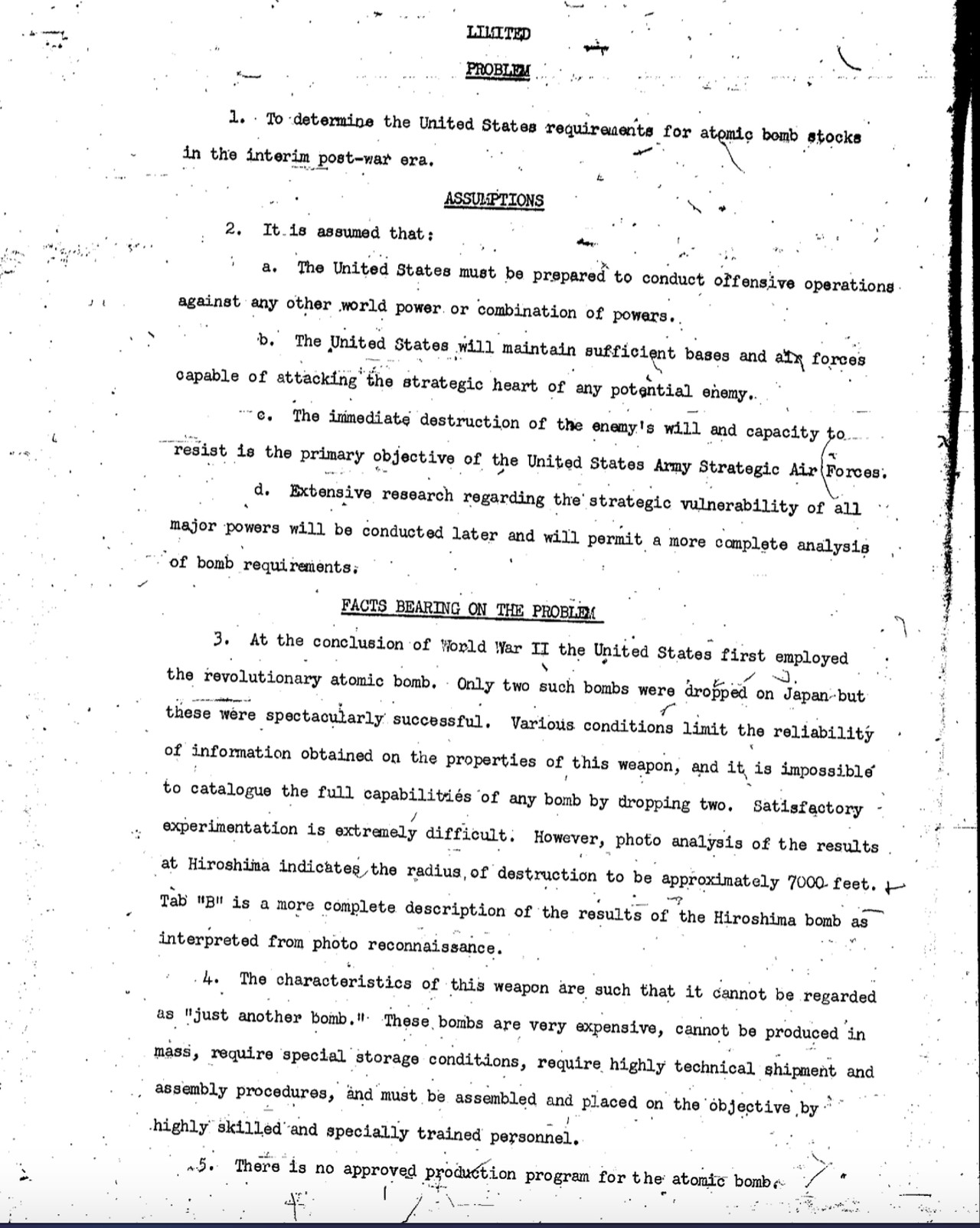
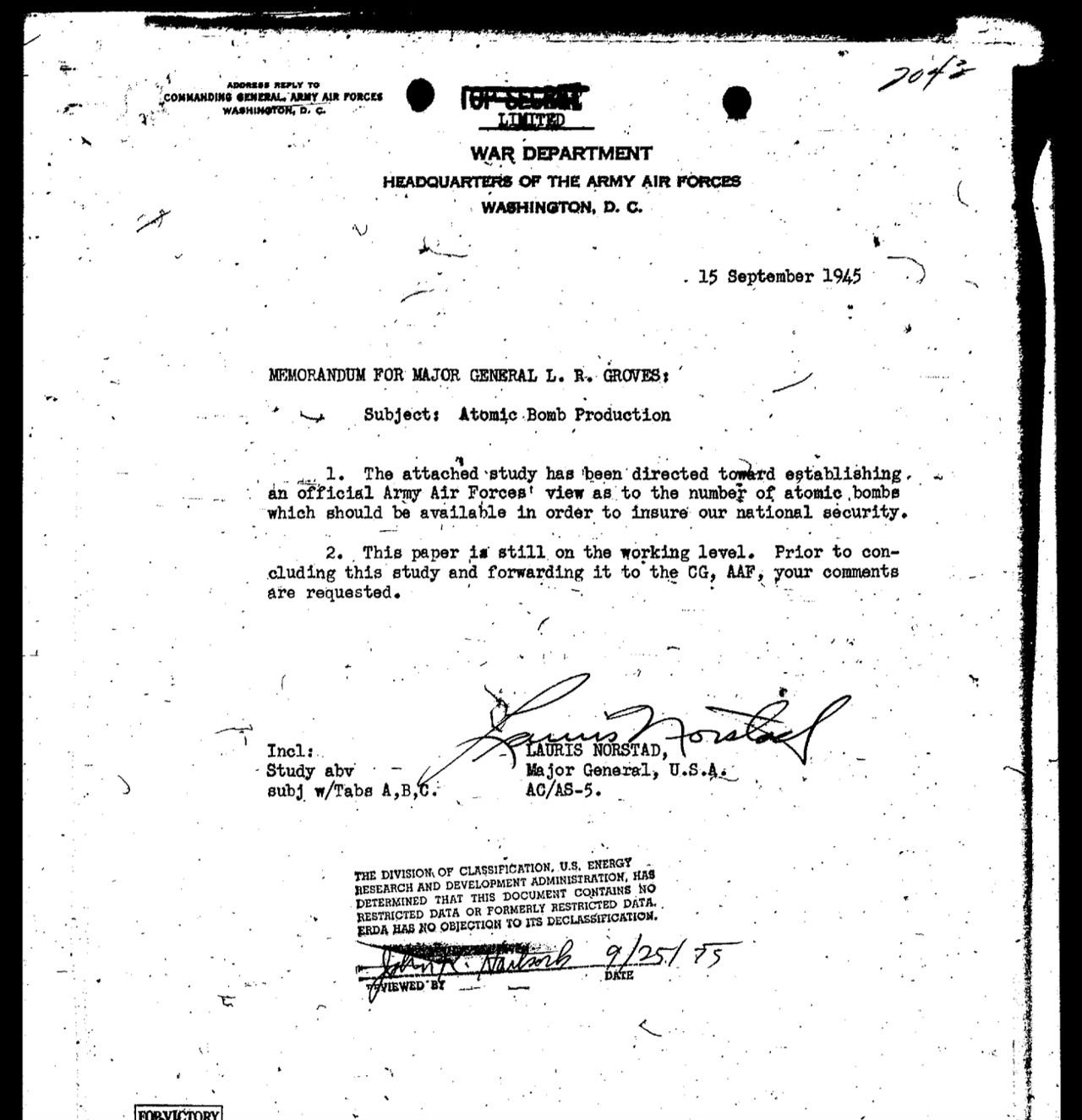
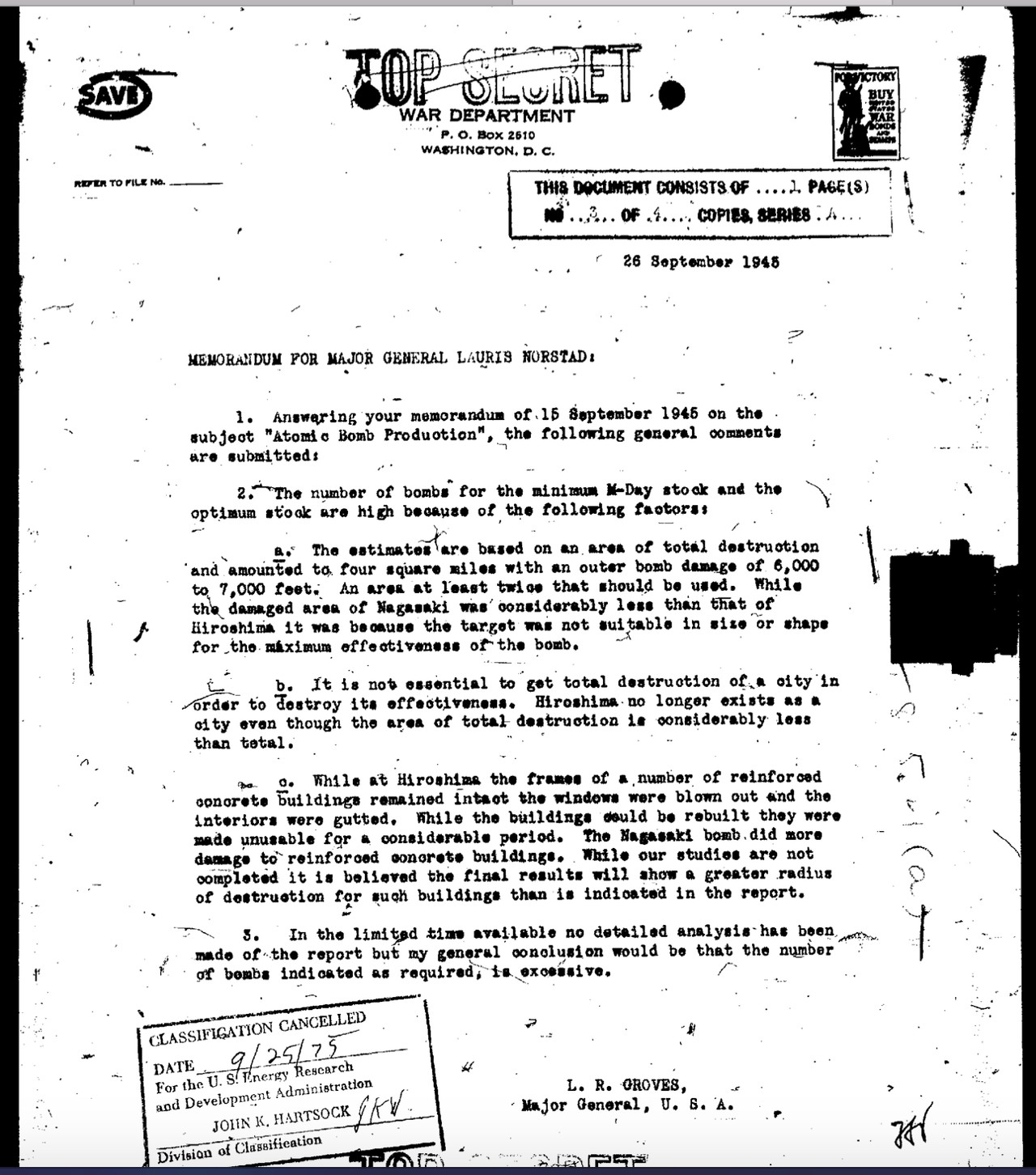
Предшественники “Дропшота”
Из числа наиболее известных и рассекреченных на сегодняшний день планов ведения тотальной войны против СССР помимо “Дропшота” известны операция “Немыслимое” (англ. Operation Unthinkable) и план “Тоталити” (англ. Totality). Оба плана были созданы в 1945 году, причем операция “Немыслимое” была разработана по приказу автора Фултонской речи Уинстона Черчилля. “Тоталити” появился в результате работы штаба американского генерала Дуайта Эйзенхауэра.
Операция “Немыслимое” предполагала два плана действий: наступательный и оборонительный. Будучи британской разработкой, она не предполагала использование ядерного оружия (оно появилось у Соединенного Королевства лишь в 1952 году), но подразумевала тотальную войну. Датой начала военных действий было выбрано 1 июля 1945 года.
Задачей наступательного плана было вытеснение советских войск с территории Польши, которая была занята в ходе освобождения Восточной Европы от немецкой оккупации. Задачей оборонительного плана была защита территории Великобритании в случае прорыва советских войск в Западной Европе.
Оба плана американскому командованию для ознакомления британцы так и не предоставили. Хотя операция “Немыслимое” предполагала, что кроме США и Соединенного Королевства “нельзя полагаться на какую бы то ни было помощь со стороны армий других западных держав”.
План не снискал одобрения у Объединенного комитета начальников штабов, который рассчитал, что быстрый успех в такой войне невозможен по причине превосходства СССР в живой силе и военной технике в 2,6 раза, а в авиации — в 1,5 раза.
План “Тоталити” был разработан США в августе 1945 года, когда на вооружение США уже стали поступать первые атомные бомбы. Их количество и производственные возможности были сильно ограничены, равно как и средства доставки (исключительно бомбардировщики). Задумывался он президентом Гарри Труманом, чтобы ввести СССР в заблуждение относительно реальных ядерных возможностей США в послевоенные годы.
“Тоталити” стал первым в истории военным планом, предполагающим бомбардировку сразу нескольких крупных городов предполагаемого противника ядерными бомбами. В списке числились Москва, Горький (Нижний Новгород), Куйбышев (Самара), Свердловск (Екатеринбург), Новосибирск, Омск, Саратов, Казань, Ленинград (Санкт-Петербург), Баку, Ташкент, Челябинск, Нижний Тагил, Магнитогорск, Молотов (Пермь), Тбилиси, Сталинск (Новокузнецк), Грозный, Иркутск и Ярославль — всего 20 городов.
Конечно же, у США не было 20 атомных бомб в августе 1945 года. Единственные две атомные бомбы были сброшены на Хиросиму и Нагасаки. Но уже к 1950 году американские ядерные запасы вплотную приблизились к 300.
А вот у СССР в том же году было всего пять атомных бомб. Такое превосходство, возможно, и породило у американского военного командования идею разработки еще более масштабного плана, чем “Тоталити”.
This video is based on the research of Prof. Michel Chossudovsky, Centre for Research on Globalization (CRG)
Below is the full text of Professor Chossudovsky’ article published by Global Research
According to a secret document dated September 15, 1945, “the Pentagon had envisaged blowing up the Soviet Union with a coordinated nuclear attack directed against major urban areas.
All major cities of the Soviet Union were included in the list of 66 “strategic” targets. The tables below categorize each city in terms of area in square miles and the corresponding number of atomic bombs required to annihilate and kill the inhabitants of selected urban areas.
Six atomic bombs were to be used to destroy each of the larger cities including Moscow, Leningrad, Tashkent, Kiev, Kharkov, Odessa.
The Pentagon estimated that a total of 204 bombs would be required to “Wipe the Soviet Union off the Map”. The targets for a nuclear attack consisted of sixty-six major cities.
One single atomic bomb dropped on Hiroshima resulted in the immediate death of 100,000 people in the first seven seconds. Imagine what would have happened if 204 atomic bombs had been dropped on major cities of the Soviet Union as outlined in a secret U.S. plan formulated during the Second World War.
Hiroshima in the wake of the atomic bomb attack, 6 August 1945
The document outlining this diabolical military agenda had been released in September 1945, barely one month after the bombing of Hiroshima and Nagasaki (6 and 9 August, 1945) and two years before the onset of the Cold War (1947).
The secret plan dated September 15, 1945 (two weeks after the surrender of Japan on September 2, 1945 aboard the USS Missouri, see image below) , however, had been formulated at an earlier period, namely at the height of World War II, at a time when America and the Soviet Union were close allies.
It is worth noting that Stalin was first informed through official channels by Harry Truman of the infamous Manhattan Project at the Potsdam Conference on July 24, 1945, barely two weeks before the attack on Hiroshima.
The Manhattan project was launched in 1939, two years prior to America’s entry into World War II in December 1941. The Kremlin was fully aware of the secret Manhattan project as early as 1942.
Were the August 1945 Hiroshima and Nagasaki attacks used by the Pentagon to evaluate the viability of a much larger attack on the Soviet Union consisting of more than 204 atomic bombs?
The Kremlin was aware of the 1945 plan to bomb sixty-six Soviet cities.
Had the US decided not to develop nuclear weapons for use against the Soviet Union, the nuclar arms race would not have taken place. Neither The Soviet Union nor the People’s Republic of China would have developed nuclear capabilities as a means of deterrence.
The Soviet Union lost 26 million people during World War II.
The USSR developed its own atomic bomb in 1949, in response to 1942 Soviet intelligence reports on the Manhattan Project.
Let’s cut to the chase. How many bombs did the USAAF request of the atomic general, when there were maybe one, maybe two bombs worth of fissile material on hand? At a minimum they wanted 123. Ideally, they’d like 466. This is just a little over a month after the bombings of Hiroshima and Nagasaki.
Of course, in true bureaucratic fashion, they provided a handy-dandy chart (Alex Wellerstein, op. cit)
Энциклопедия вооружения
Каталог вооружения
Патрон 4.5×40 R
Патрон 4.5x40R, 1969, Россия

Тактико-технические характеристики патрона 4.5×40 R (СПС)
Калибр, мм – 4,5х40 R (СПС)
Длина патрона, мм – 145
Длина пули, мм – 115
Масса патрона, г – 21
Масса пули, г – 13,2
Средний вес порохового заряда, г – 1,3
Начальная скорость, м/с – 240
Максимальное давление пороховых газов, кг/см2 – 2900
Дульная энергия, дж – 412
Средняя кучность R50 на воздухе на дальности 5 м, см – ≤5,0
В 1969 году для нужд Военно-Морского флота и вооружения боевых пловцов ВМФ СССР в Советском Союзе были начаты работы по созданию подводного огнестрельного оружия. В результате были разработаны два подводных комплекса, пистолетный и автоматный, основанные на активном принципе метания пули.
В состав пистолетного комплекса, разработанного ЦНИИ Точного Машиностроения, вошел 4,5-мм патрон СПС (со стальной пулей) и специальный пистолет подводный СПП-1 (СПП-1М), который был принят на вооружение военно-морских сил СССР в 1970 году.
 СПП-1, СПП-1М (Специальный Пистолет Подводный) – российский (советский) подводный пистолет, стал личным оружием пловца-аквалангиста, предназначенным для поражения подводных целей, как диверсантов, так и морских хищников. Огонь из пистолета ведется одиночными выстрелами. Пистолет несамозарядный, имеет блок из четырех стволов (стволы гладкие, без нарезов), откидывающийся на шарнире вниз для перезаряжания.
СПП-1, СПП-1М (Специальный Пистолет Подводный) – российский (советский) подводный пистолет, стал личным оружием пловца-аквалангиста, предназначенным для поражения подводных целей, как диверсантов, так и морских хищников. Огонь из пистолета ведется одиночными выстрелами. Пистолет несамозарядный, имеет блок из четырех стволов (стволы гладкие, без нарезов), откидывающийся на шарнире вниз для перезаряжания.
 Специальный патроны для этого пистолета объединяются в один блок при помощи плоской стальной обоймы, и извлекаются из стволов или заряжаются в них одновременно.
Специальный патроны для этого пистолета объединяются в один блок при помощи плоской стальной обоймы, и извлекаются из стволов или заряжаются в них одновременно.
Боекомплект пистолета СПП-1 включает 16 патронов 4.5×40 R в 4 обоймах (одна с пистолетом в кобуре, три в герметичных металлических пеналах).
Первый вариант активного патрона разработки Ширяева Д.И. состоял из латунной гильзы с рантом, длинной цельнометаллической пули из нержавеющей стали и заряда пороха марки ВТ. Пуля имела плоскую вершинку и винтовые наклонные нарезы, для придания дополнительной закрутки. Диаметр пули составлял 4,5-мм только в области ведущего пояска, а диаметр тела по всей длине пули составлял 3,95 мм.

Для этого пистолета Матвейкиным и Касьяновым были разработаны варианты пуль, получивших обозначения «турбовинтовая» и «турбопропеллерная», которые отличались повышенной устойчивостью траектории движения под водой.
Поначалу в мелкосерийное производство был запущен патрон с турбовинтовой пулей, имевшей четыре наклонных проточки на вершинке пули. От опытной пули Ширяева, эта пуля отличалась меньшей массой – 13,2 г против 13,5 г, диаметр пули – 4,41 мм против 3,95 мм, пуля была короче на 30 мм, и у неё отсутствовал ведущий поясок. Пуля имела защитное антикоррозийное лаковое покрытие.

Так как обычные пули в воде теряют эффективность уже на самых малых дальностях (менее 1 метра), для подводного пистолета был разработан специальный патрон, отличительной особенностью которого стала иглообразная пуля большого удлинения.
По сути дела, эта стальная пуля массой 13,2 г представляла собой удлиненный стальной стержень длиной 115 мм (соотношение длины к калибру — 25:1). По форме наружного очертания пуля имела удлиненную ведущую часть и оживал, при этом заостренный оживал пули был выполнен на конус. Вершина оживала имела притупленную форму.
Позднее было установлено, что стабилизация пули достигается не за счёт закрутки пули при помощи винтовых насечек, а за счёт эффекта кавитации. Для обеспечения устойчивости кавитационного эффекта была изменена форма кончика пули на усечённый конус.
 Во время стрельбы в воде пуля подобной конструкции при высокой скорости движения стабилизировалась гидродинамически за счет кавитационной полости (каверны), генерируемой небольшой плоской площадкой на переднем заостренном конце пули, которая удерживалась на протяжении всего полета пули.
Во время стрельбы в воде пуля подобной конструкции при высокой скорости движения стабилизировалась гидродинамически за счет кавитационной полости (каверны), генерируемой небольшой плоской площадкой на переднем заостренном конце пули, которая удерживалась на протяжении всего полета пули.
Благодаря этому пуля имела эффективную дальность стрельбы из пистолета СПП-1 (СПП-1М) составляет на глубине 5 метров – до 17 метров, на глубине 20 метров – до 11 метров. На этих дистанциях пуля калибра 4,5 мм обеспечивает поражение живой цели, защищенной маской из оргстекла толщиной до 5 мм и одетой в утепленный поролоновый костюм с дополнительно укрепленными 5-мм пластинами из фибергласса. Форма пули обусловила и то обстоятельство, что стволы перспективного подводного пистолета должны были быть гладкими, без нарезов.
Общая длина 4,5 мм патрона СПС составляла 145 мм, а масса — 21 г. Полет такой удлиненной пули патрона СПС в воздухе никак не стабилизировался, поскольку для пули большого удлинения стабилизация вращением была неэффективна, и она из-за своих формы и габаритов быстро теряла устойчивость. Поэтому стрельба в воздушной среде патронами СПС была возможна только на очень на малой дальности — до 20 м, однако она сохраняет убойное действие и наносит достаточно серьезные ранения. Начальная скорость пули на воздухе составляет 250 м/с, дульная энергия — 412 Дж.
 Латунная гильза патрона СПС (4.5×40 R) — бутылочной формы, фланцевая (с выступающей закраиной) длиной 40 мм, предназначалась для соединения в одно целое всех элементов патрона, а также облегчала заряжание оружия и предохраняла пороховой заряд от влияния внешних условий. Для этого были предприняты специальные меры по герметизации и повышению коррозионной стойкости подводного патрона.
Латунная гильза патрона СПС (4.5×40 R) — бутылочной формы, фланцевая (с выступающей закраиной) длиной 40 мм, предназначалась для соединения в одно целое всех элементов патрона, а также облегчала заряжание оружия и предохраняла пороховой заряд от влияния внешних условий. Для этого были предприняты специальные меры по герметизации и повышению коррозионной стойкости подводного патрона.
Крепления пуль и капсюлей в патронах надежно герметизированы специальным лаком и обеспечивают срабатывание патронов после длительного пребывания в воде.

[description]Первый образец патрона СПС. Длиной 165 мм. Пуля из нержавеющей стали.[/description]
4,5х40R СПС-У

Тактико-технические характеристики патрона 4.5×40 R СПС-У
Диаметр пули, мм – 4,5
Вес патрона, г – 16,5
Длина патрона, мм – 145
Маркировка – три продольных канавки на гильзе
Учебный патрон CПС-У предназначен для обучения обращения с оружием и боеприпасами. Патрон состоит из латунной гильзы с охолощённым капсюлем и стальной игловидной пули. Улучшенное крепление пули обеспечивается обжимом дульца гильзы в двойную каннелюру пули.
Серийный выпуск патронов 4,5-мм СПС был налажен на заводе №38 (Юрюзанский механический завод). У патронов раннего образца стык гильзы с капсюлем и пулей покрывался герметиком белого цвета, а позднее – чёрного. Серийные патроны имели маркировку – донное клеймо в виде двух точек. Гильзы опытных патронов не имели донного клейма. Патроны упаковывались в картонные коробки по 24 штуки, 384 штук патронов в металлической коробке и 768 штук патронов в деревянном ящике.
Патрон калибра 4.5x40R может иметь следующие обозначения:
4.5x40R SPP-1M underwater 4 barrel pistol / 4.5 Soviet Scuba Pistol / 4.5×39.5 R / 4.5 mm SPS / SAA 0125 / XCR 07 040 BBC 010.
Soviet Pistols: 5 Combat Handguns Used by the Red Army
Tracing the history and development of five Soviet pistols, including the Tokarev TT and Makarov PM.
Maxim Popenker

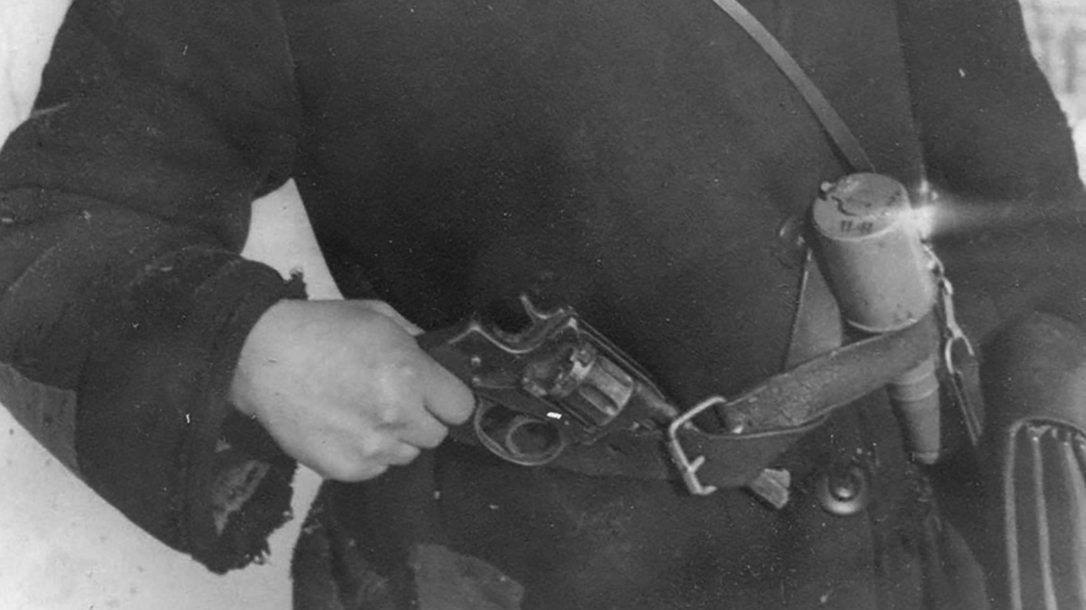

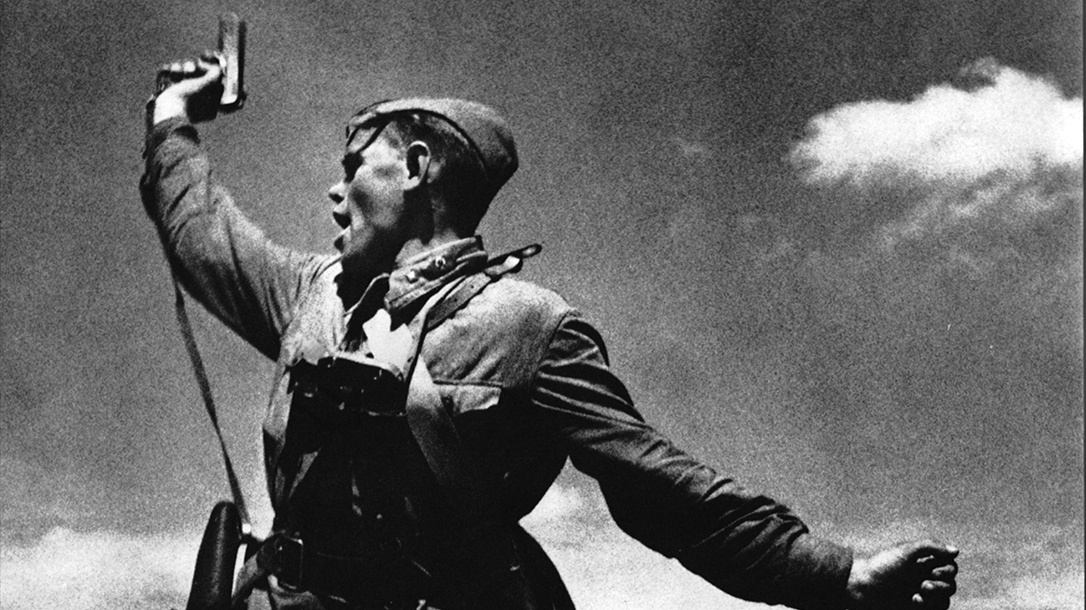
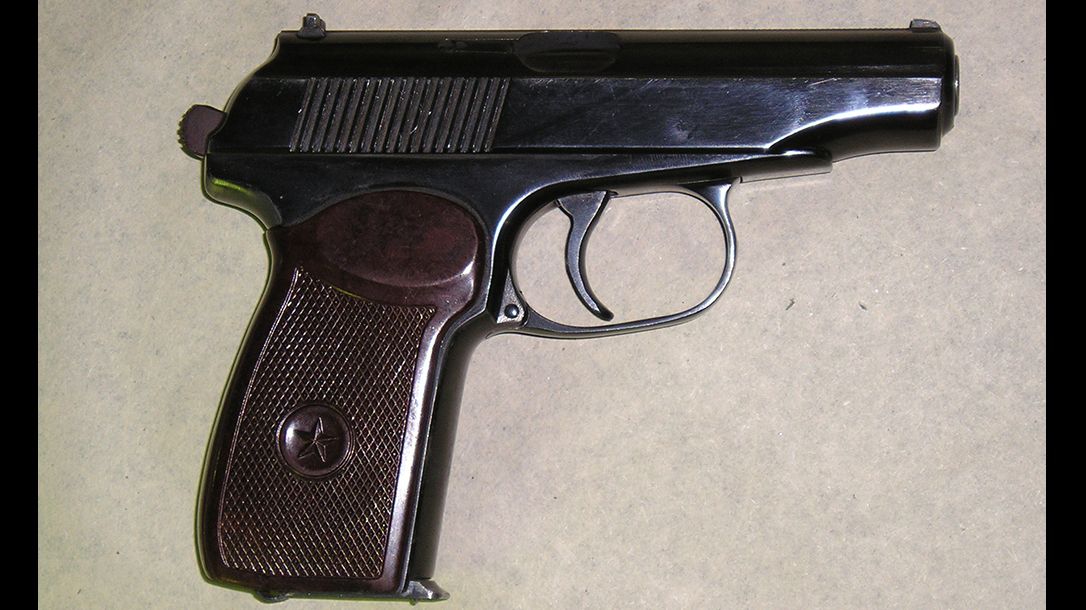
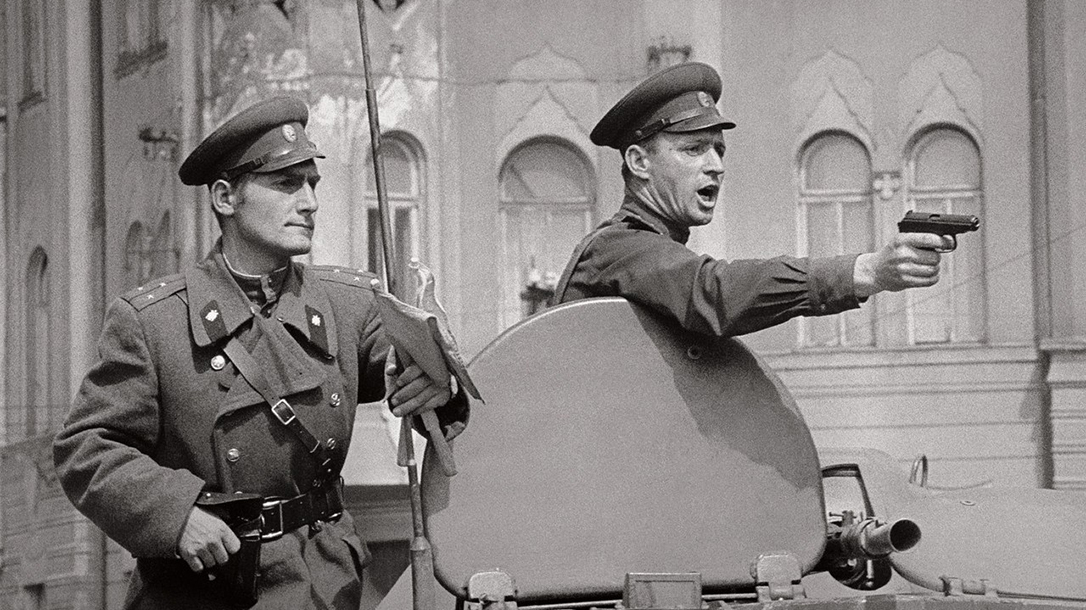
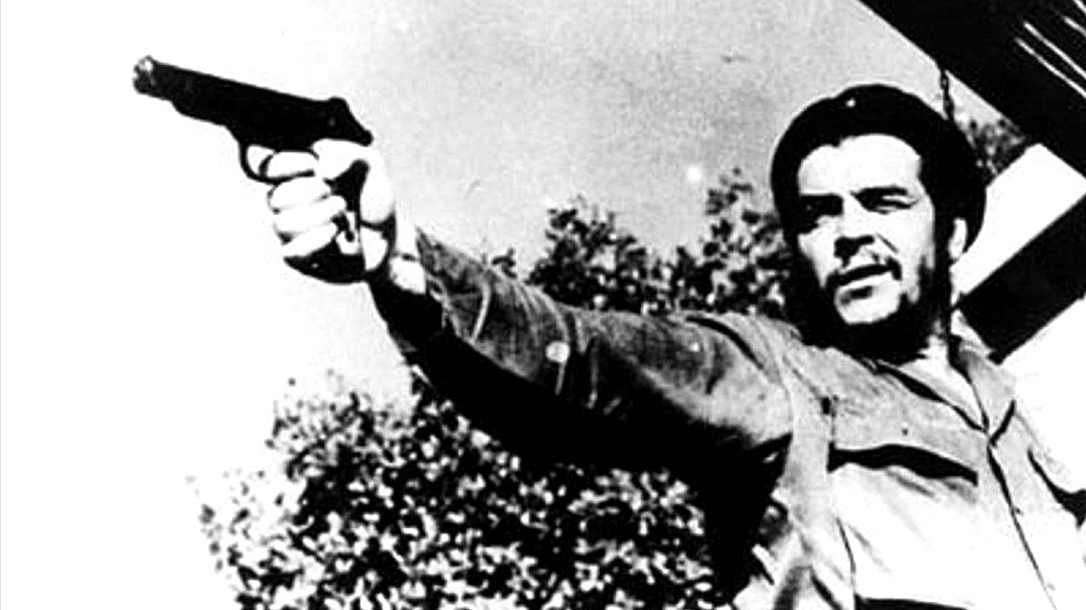

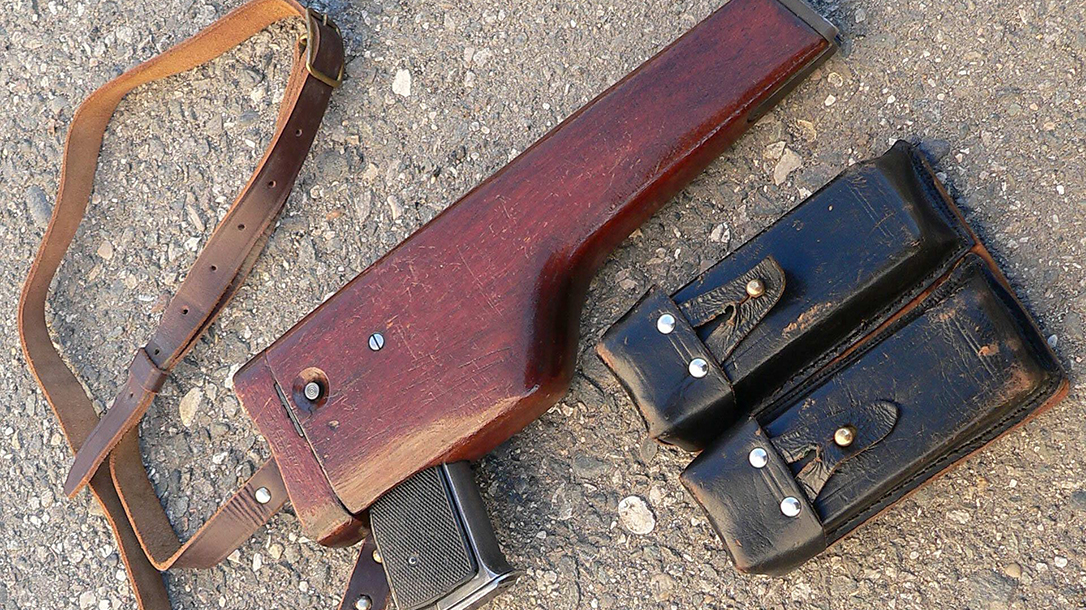

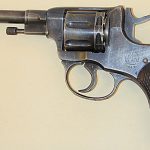

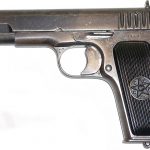
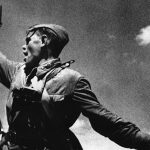
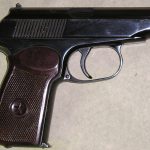
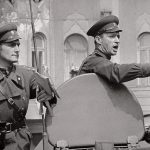

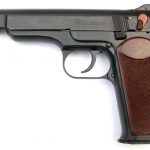

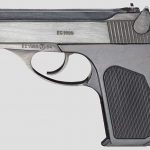
The Red Army was officially formed in January of 1918. During its first decade, it was armed with legacy guns of the fallen Russian Empire, including Nagant M1895 revolvers. Recognizing the need for a more modern service sidearm, the Red Army initiated trials for a new semi-automatic pistol during the late 1920s that eventually resulted in the adoption of the Tokarev TT pistol in 1931.
After certain improvements, the TT was put into mass production in 1933. This version, produced in the millions in the USSR and elsewhere, is generally known as TT-33. However, due to insufficient production of the TT, Nagant revolvers were produced concurrently with the more modern pistols.

Hollywood AKs: 9 Films That Showcase the AK-47 and Its Variants
The TT was a short-recoil-operated, locked-breech pistol with a Browning-type action. The hammer, spring and sear formed a single unit. The unit was easily removed during field disassembly, simplifying routine maintenance of the pistol. It used single-stack, eight-round magazines, with the magazine release button located at the base of the triggerguard.
It must be noted that the TT left a lot to be desired; as early as 1938, new trials were organized to find a better gun. The Main Automotive-Armored Tank Directorate (GABTU) requested a manual safety and a pencil-thin barrel. This was so the new gun could be fired through ports in armored cars and tanks. These ports were originally designed to accept thin Nagant barrels, and the TT’s slide was too big to fit in. Due to the breakout of World War II, these trials were abandoned; the Red Army fought the “Great Patriotic War” with both semi-automatic Tokarev TT pistols and Nagant M1895 revolvers.
Soviet Pistols After The War
Wartime experience, which included a close and sometimes very personal familiarity with German pistols, resulted in a major change of thinking about the role and necessary features of a military pistol for the Soviet army. Another factor that played a major role in the development of new requirements for the next military pistol was the realistic prospect of World War III, with massive nuclear bombings and other such large-scale actions. As a result, pistols played a very minor role in both strategic and tactical doctrines of the Soviet army. Furthermore, Tokarev pistols, despite being relatively simple and powerful, showed significant deficiencies. Some of these were quite serious, such as the lack of a positive safety. Consequently, almost immediately after the war, the Artillery Department issued a new set of requirements for a military and police pistol.
These requirements asked for a compact double-action pistol of the “Walther PP type.” New pistols were to be submitted in three calibers. The calibers were .32 ACP (7.65mm Browning Short), .380 ACP (9x17mm Browning) and the new 9x18mm. The last of these had initially been developed just prior to the war and refined after by the designer Syomin. Apparently, this round was inspired by the German 9x18mm Ultra, which was designed in the mid-1930s to provide “acceptable maximum power” in simple, pocket-sized blowback pistols.
Firepower
The key reason for the increase in caliber when compared with the West’s 9x19mm rounds is unknown (the Soviet 9x18mm has a bullet diameter of 9.2 millimeters while most Western 9x19mm rounds have a bullet diameter of 9.02 millimeters). However, with the benefit of hindsight, we can assume that the reasons for such an increase were probably similar to those behind Soviet 82mm mortars. Those mortars were able to load and fire the slightly smaller German 81mm mortar bombs, but not vice versa.
Also, while the Soviet army was ahead of many others in the request for a double-action pistol, it regressed somewhat in adopting a marginally powerful round in a weapon that in essence was a pocket-type pistol. Around the same time, many other armies, also looking for an increase in power, started to change their “weak” .32 ACP, .380 ACP or 7.65x20mm pistols to the more potent 9x19mm. The explanation for this, however, is rather simple—while most Western countries relied on full-power rifles (bolt action or semi-automatic) and submachine guns as a primary individual armament for the infantry, the new Soviet concept had no place for submachine guns, as the only primary arm of the infantry was the newly developed assault rifle.
Most Western pistols were also required to fire 9x19mm ammunition just to have commonality in ammunition with the standard-issue submachine guns; Soviet designers had no such requirements. By the late 1940s, the 9x18mm looked like it was good enough for a military pistol.
Makarov PM
Trials for a new pistol began in 1947. Many designs were submitted and tested, such as pistols from Baryshev, Rakov, Voevodin, Simonov and Makarov. Some designs were submitted in only one of the desired chamberings, some, such as the Makarov design, in two, and a few in all three. At the same time, the army also tested a few larger machine pistols in 9x18mm that were intended as personal-defense weapons for certain officers and NCOs. In 1948, the first trials resulted in the selection of the Makarov pistol in 9x18mm as the next military sidearm for Soviet armed forces. However, it took three more years to refine its design before it was officially adopted in 1951 as the Pistolet Makarova, or PM.
The blowback-operated PM used a fixed barrel. It was an all-steel design with a double-action trigger and an exposed hammer. In addition, the slide-mounted safety doubled as a decocker. Furthermore, the magazine release was located at the base, or heel, of the grip, and the gun used eight-round magazines.
Stechkin APS
That same year, the Soviet army also adopted the 20-shot, select-fire Stechkin APS pistol in the same caliber. It was chosen over two similar machine pistols designed by the then-unknown Mikhail Kalashnikov and Voevodin (who designed several pistols just before the war). The Stechkin APS also used a fixed barrel and a double-action trigger. The three-position fire control selector offered safe, semi- and full-auto positions. It also forced the hammer to decock safely when gun was set on “safe.”

AK Dominance: A History of the World’s Most Popular Rifle Platform
To provide controllable full-auto fire, the APS was also fitted with an inertia-type rate reducer made in the form of a steel plunger that reciprocated up and down in the grip, just behind the magazine channel. When the pistol was fired in full-auto, the slide hit the plunger and forced it down against its spring at the end of its forward movement; at the same time, the hammer was held cocked by the automatic sear. Once the plunger completed its down-and-up cycle, it struck the sear and thus released the hammer to fire the next shot.
However, unlike the Makarov PM, the Stechkin APS had a relatively short production life. Made only between 1951 and 1955, this gun turned out to be overly expensive and complicated to make. Furthermore, workers called it the “machinist’s worst nightmare.” Its wooden or plastic holster/shoulder stock was bulky and often cumbersome to carry; many complaints from tank and APC crews were caused by the holster snagging on armored vehicles, especially during emergency exits. Most of the APS pistols were withdrawn from service and put into storage by the early 1960s, replaced either by Makarov pistols or Kalashnikov AKS/AKMS folding-stocked assault rifles.
Retired TT, Evolving Makarov
Also, it should be noted that while the TT was declared obsolete in 1951, it remained in service with the Soviet army until the early 1970s, and some rural militias carried these guns well into the 1980s.
The following decades saw the gradual evolution of Makarov pistols in continuing attempts to produce new pistols with fewer rejects and at lower cost. Most efforts concentrated on production technologies. Furthermore, by the 1980s, many parts that were initially made with machining and hand-fitting became precision castings that required minimal, if any, fitting. The 1980s also saw attempts to make PM pistols lighter with the introduction of aluminum alloy and polymer frames. Apparently, these pistols were less durable than steel-framed ones and development was terminated.
The last pistol to be mentioned here is the diminutive PSM. It was designed during the early 1970s as a deep-concealment pistol for KGB agents. It was also very thin (only 0.7 inches across its widest part) thanks in part to the safety arrangement, in that the lever was made flat with the slide and protruded rearwards, along with the hammer. The PSM also used single-stack magazines; a small finger rest and magazine release located at the heel of the grip. The sights were fixed. Early production pistols had very thin ribbed aluminum grip panels, but these were found to be quite uncomfortable, and later were replaced with plastic wraparound grip panels.
Most importantly, the PSM fired a specially designed, bottlenecked 5.45x18mm cartridge that offered good penetration but poor stopping power. As a result, it was most often used as a general’s gun, and there’s a quite a list of cases where well-placed shots fired from PSM pistols failed to incapacitate or kill a target in a timely manner, including several very painful suicides.
This article was originally published in the 2018 issue of “AK-47 & Soviet Weapons.” To order a copy, visit outdoorgroupstore.com.
Sign-up today!
I have read the Terms of Use, Privacy Policy, and Cookie Policy, and I hereby agree to those terms. For purposes of clarity, I consent to Athlon’s collection, storage, processing, and transfer of my Personal Data and Non-Personal Data (as defined in the Privacy Policy) for the purpose of signing up for the email newsletter.
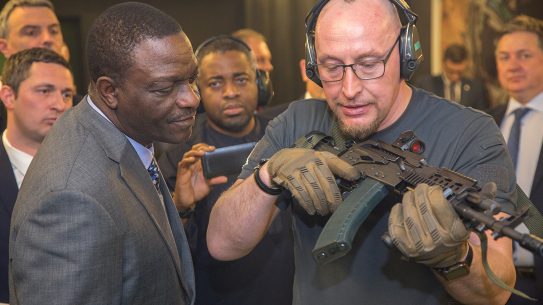
Nigeria to Begin Manufacturing the Polish FB Beryl M762 Rifle
The FB Beryl, a rifle made in Poland by Fabryka Broni, is set to.
by Tactical-Life / Apr 9, 2018



